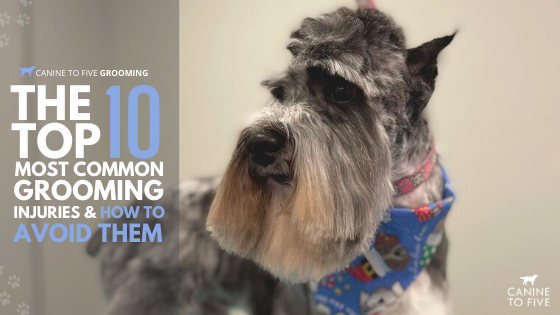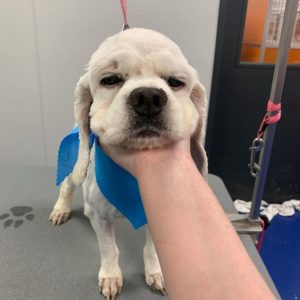The Top 10 Most Common Dog Grooming Injuries and How to Avoid Them

Have you ever thought to yourself, “Wow, dog grooming costs more than my own haircut!” If so, you’re not alone! Many pet parents compare their own hair stylist to the ones that groom our four-legged friends, so when accidents happen – they’re hard to understand.
One of the biggest differences between you getting your hair done, and your dog visiting the groomer, is the fact that your dog’s hair is not the only thing our groomers are taking care of. Between tear stains, ear cleaning, nail trims, and anal gland expressions, your pup’s groomer provides so much more than a simple wash and cut. This broad level of service not only relies on your dog to stay still, but it relies on you as a pet parent to provide preventative care that will make their visit worry free.
Read on to learn the top 10 most common grooming injuries, and how you can help avoid them!
1 & 2. Brush & Razor Burn
Sometimes dogs have sensitive skin and it isn’t something you can see or tell from just looking at it. When a trip to the salon involves repetitive brushing in the same area, whether there are tangles or matting, it can burn sensitive skin.
Similar to brush burn, razor burn happens when an area is shaved very close to sensitive skin. This can be due to matting, or cleaning up a dog’s sanitary area. It can also be caused from a dull or hot razor after shaving through thick matted, or pelted, hair.
Groomers and pet parents don’t typically notice these burns until after the irritation has caused their dog to lick, scratch, and sometimes break open the skin. Keeping your dog brushed between visits, and using the right kind of brush, can help reduce the need for excessive brushing, or shaving close to the skin. Check out our At-Home Guide to Brushing Your Dog to make sure you’re brushing the right way!
3. Hematomas
When a dog has tight matted hair, the blood flow is restricted to that area. When that matted hair is removed, blood rushes back to the area quickly, which can cause a large blood blister called a hematoma. These commonly occur in a dog’s ear and require a vet visit to remedy. Brushing your dog properly in between visits will help reduce the risk of matting, and can save your pup from this painful experience. Check out our At-Home Guide to Brushing Your Dog to make sure you’re brushing the right way.
4. Nicks & Scrapes
Nicks are small cuts made by scissors or clippers that can happen for a variety of reasons; If a dog is very jumpy or wiggly, if a dog’s skin if very thin (senior dogs especially!), if a dog has very tight matting or is pelted, or if there are hidden scabs, moles, or warts.
- Starting your dog in the salon as early as 12 weeks old will help them feel more comfortable with their groomer. Requesting the same groomer each time can also help form a relationship, making your dog less likely to bite, thrash, or jump around on the grooming table. The more calm your dog is for their appointment, the safer they are, and the better their haircut will be! Practicing a grooming routine at home with your puppy will help them get used to the experience as well. We recommend brushing, gently rubbing your dog’s paws, and wiping around their eyes, all while offering treats to keep it positive.
- Matted hair, especially on thinner skin under armpits or between toe webbing, is prone to cuts and scrapes depending on the thickness of the matting. Sometimes trying to find where the hair ends and where the skin starts can be difficult, which is why you should never attempt to cut matted hair yourself at home. Scheduling your appointments regularly every 6 – 8 weeks is highly recommended, and will help prevent a majority of issues that can arise with grooming. Brushing your dog properly in between visits will help reduce the risk of matting as well.
- It is important to make your groomer aware of any moles, scabs, or warts on your dog. These generally pop up more and more as your dog gets older, and be caught on when shaving or scissoring. Canine to Five’s groomers keep a record for each dog on where these are located for future visits.
5. Ear Plucking Irritation
Ear plucking is when a groomer pulls the hair out of a dog’s ears to prevent matting and buildup. Irritation and discomfort can come from this process when attempting to pluck hair that may not be ready to come out yet. It can also be itchy and create a dog to be head shy if they aren’t used to this process. Canine to Five’s groomers only perform this process upon request.
- It’s important for pet parents to do their own research when it comes to ear plucking. Professionals in both the grooming and veterinary world have varying opinions on the benefits and set backs of this process, but ultimately it is up to you!
6. Quicked, Overgrown, & Broken Nails
Nail trimming can be tricky! But if your pup’s paws don’t receive this routine care, they will be more prone to being quicked, overgrown, or broken.
- Quicked nails are everyone’s nightmare! Cutting a nail too short can cause them to bleed due to a blood vessel stored inside each nail. While our groomers are the experts, this can happen if your dog has naturally longer blood vessels. Longer blood vessels typically occur in the nail when they’ve had a longer time to grow. Routine nail trims will help these blood vessels recede, making each nail trim shorter and easier for everyone involved.
- Overgrown nails make it easier for a nail to be quicked due to the blood vessel growing longer. Much like human fingernails, a dog’s nails do not stop growing! They will curl outward – or worse, inward – making it painful and difficult for your dog to walk. After they have their overgrown nails trimmed, they may limp or be extra sensitive now that they can walk normally on their sore paws.
- Broken nails, or split nails, can occur from overgrown nails either breaking off dangerously short, or cracking and exposing the blood vessel. Unlike quicking the nail, which can be remedied at home or in the salon, broken nails and split nails must be seen by a vet! This can be very painful for a dog and, if left untreated, can lead to infection.
7. Anal Gland Irritation
Anal glands are little sacs just inside your dog’s anus that express naturally when a bowel movement is passed, or when your dog gets frightened. It is generally a good idea to let your dog take care of this on their own, but occasionally you may notice your pup scooting, straining, smelling fishy, or licking the area, and will want to call in some help! When visiting the groomer, they will simply express them externally by squeezing from the outside. This does not fully empty the glands, but can help get your pup started! If your dog is having more serious issues and you see leaking, bleeding, or swelling, you may need to contact your vet to have them expressed internally.
- Canine to Five’s groomers will only do this process upon request. Having anal glands expressed manually on a regular basis can weaken your dog’s muscles, having their body rely on this manual process instead of expressing them naturally. This can lead to blockage, and even them rupturing, if not kept up with.
8. Eye Irritation
Your dog’s eyes are very sensitive! Some pups have natural eye discharge that can cause watery eyes, tear stains, or eye goop/crust. If your dog is prone to eye discharge, it is important to wipe them daily, even if you’re not bothered by tear stains.
Discharge can usually be soaked off in the tub by lathering up the area with warm water and massaging out, or combing out, the discharge with a small flea comb. If the discharge is too tight to the skin, or too mass spread around the eye area, it can cause discomfort, and even house infections due to moisture getting locked in at the root.
If eye discharge has been caked onto a dog’s skin for a long period of time, removing it can leave the area sore, itchy, and raw, causing a dog to rub their face on anything that will provide them relief. This can cause even more irritation, and requires a trip to the vet office.
9. Sanitary Matting
Fecal matting, penile matting, and vaginal matting are discomforting things that we see in our salon, and can occur when hair is not brushed thoroughly in these areas. Sanitary matting can cause infection and irritation, so keeping these areas trimmed short and brushed thoroughly is very important. For pet parents who like to keep their pup’s coat long, our groomers recommend getting a “Face, Feet, and Fanny” trim in between their full grooms. This allows their coats to stay long, while these problem areas can remain clean.
Once sanitary matting is removed, the dog’s sanitary area will be very sore. This can cause them to over-lick and rub the area, prompting the need for a vet visit.
10. Yeast Infections
Yeast can grow anywhere on your dog’s body where it’s moist, but ears are a favorite! Yeast inside the ear canal can be itchy, which causes your dog to scratch excessively. A dog will use their feet to scratch inside their ears to relieve the itch, causing the yeast to spread to their feet! Once on their feet, yeast can spread to other areas on their body, leading to a bigger problem.
Yeast can make dog grooming difficult because it forms flaky and sticky skin that clippers can catch on, making a dog uncomfortable. Skin that is flared up from scratching, whether its from yeast, dry skin, or fleas, can create scabby areas. Not to mention that scabby and flared up skin can feel more irritation from shampoo!
Keeping your dog’s ears, feet, and skin folds/wrinkles dry is your best defense against yeast. Whether you’re bathing at home, they just got done swimming, or they’re coming in from the rain, drying off areas that easily trap moisture will help prevent infections, bacteria growth, and hot spots. Brushing your dog regularly to prevent matting will also help reduce the amount of areas on your dog that can trap moisture.
Fortunately your hair stylist doesn’t need to worry about these common grooming challenges! Finding the right dog grooming salon starts with making sure each member of the team is experienced, transparent, and communicative. Canine to Five’s grooming salon in Detroit has stylists that have over 40 years of combined experience, and are Pet CPR & First Aid certified, with morning appointments available 7 days a week. Scheduling your appointments regularly every 6 – 8 weeks is highly recommended, and will help prevent a majority of issues that can arise with grooming.















